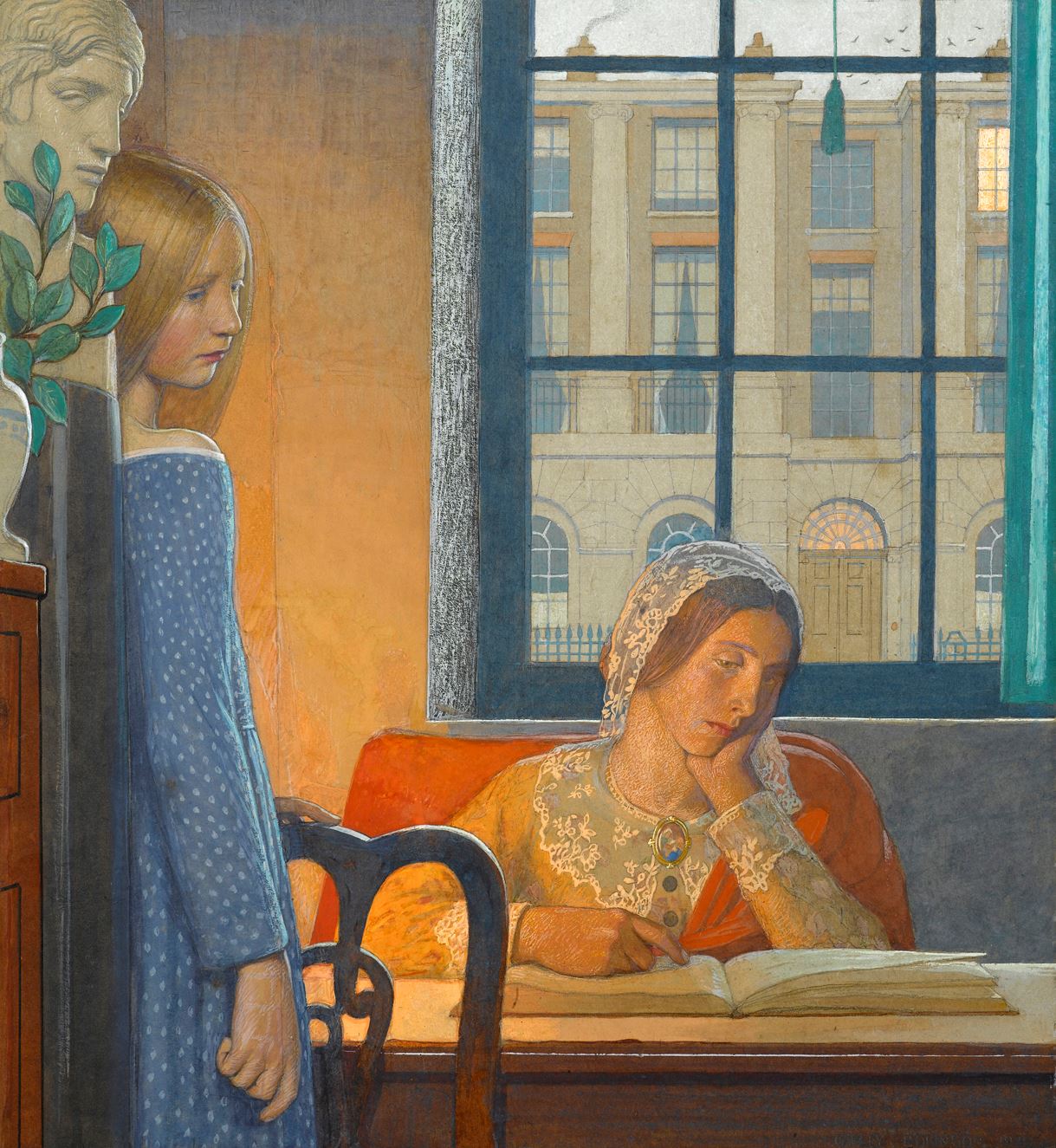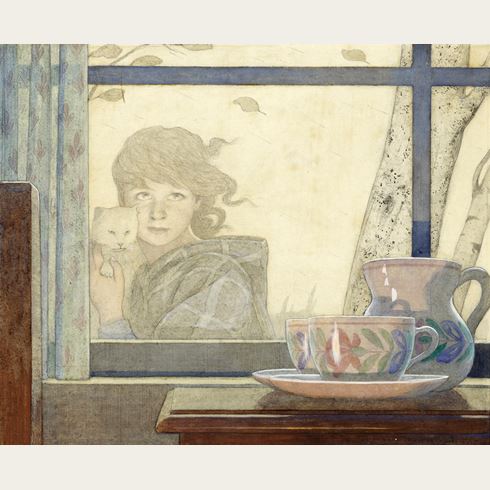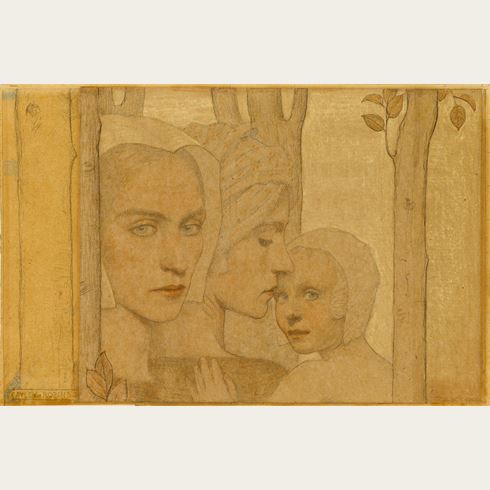Frederick CAYLEY ROBINSON
(Brentford-on-Thames 1862 - London 1927)
Evening in London
Tempera, watercolour and pencil on paper, laid down on board.
A separate sheet of paper pasted onto the main sheet at the left.
Signed and dated CAYLEY ROBINSON 1920 at the lower right.
Inscribed ‘“Evening in London.” / F. Cayley Robinson. / In the possession of Cecil French, Esq." on the backing board.
375 x 340 mm. (14 3/4 x 13 3/8 in.)
A separate sheet of paper pasted onto the main sheet at the left.
Signed and dated CAYLEY ROBINSON 1920 at the lower right.
Inscribed ‘“Evening in London.” / F. Cayley Robinson. / In the possession of Cecil French, Esq." on the backing board.
375 x 340 mm. (14 3/4 x 13 3/8 in.)
Among the most common themes in Frederick Cayley Robinson’s oeuvre is that of women or girls in enclosed interior spaces, often lit from both a light source within the room and from a window beyond. As Charlotte Gere has noted, ‘It is tempting to compare the interiors which are perhaps his most successful works, with those of his French contemporaries Bonnard and Vuillard; but close examination reveals that their atmosphere has less in common with the intimism that inspired the nabis than with the quietism of the Cotswold artists and authors. In Cayley Robinson’s pictures it takes on an almost sinister quality, and one feels that the figures in their airless rooms are brooding on ancient mysteries.’
As another modern scholar has written, ‘Cayley Robinson’s pictures are almost always of people, denizens of a silent, timeless world. There are symbolic allusions but no clear cut messages...Cayley Robinson suggests an artist who, almost consciously, evaded worldly success; his life and work evoke that of a musician who, with only a limited number of notes available to him, is able to create a corpus of amazingly subtle harmonies which is neither forced nor false.’
The present sheet may be related to a number of other, similar depictions of women in interiors, often incorporating standing or seated figures at the left edge of the composition, looking onto the scene. A large painting entitled A Winter’s Evening, dated 1918 and formerly in the Drage collection, was on the London art market in 2003, while another sizeable painting of the same title, dating from 1899 and exhibited at the Royal Society of British Artists that year, appeared at auction in 1995 and 2001.
The present sheet was, in all likelihood, acquired directly from the artist by his friend, the Irish artist Cecil French (1879-1953). A painter, printmaker and illustrator, French seems to have abandoned painting after around 1903, devoting himself instead to assembling a collection of works by late 19th and early 20th century painters. Most of the artists whose works he collected were largely unappreciated by the 1930s and 1940s, when he was most active, and he was able to acquire works by Edward Burne-Jones, Simeon Solomon, Frederic Leighton, Albert Moore, Dante Gabriel Rossetti and others. Among living artists, French was particularly fond of the work of Cayley Robinson, William Shackleton and Edward Stott. At his death his collection was left to several museums, including the British Museum, the William Morris Gallery in Walthamstow, the Guildhall Art Gallery in London and the Fulham Library.
In 1922 Cecil French published an article on Cayley Robinson’s work in the magazine The Studio, in which he noted that ‘it was the infrequent appearance of Cayley Robinsons at the [Society of] British Artists that drew me, as a boy, to those exhibitions. The potency of spell, the visionary strangeness, the almost desperate sincerity, of the new, mysterious, isolated artist brought to mind the first strenuous beginnings of the English Pre-Raphaelite group.’
As another modern scholar has written, ‘Cayley Robinson’s pictures are almost always of people, denizens of a silent, timeless world. There are symbolic allusions but no clear cut messages...Cayley Robinson suggests an artist who, almost consciously, evaded worldly success; his life and work evoke that of a musician who, with only a limited number of notes available to him, is able to create a corpus of amazingly subtle harmonies which is neither forced nor false.’
The present sheet may be related to a number of other, similar depictions of women in interiors, often incorporating standing or seated figures at the left edge of the composition, looking onto the scene. A large painting entitled A Winter’s Evening, dated 1918 and formerly in the Drage collection, was on the London art market in 2003, while another sizeable painting of the same title, dating from 1899 and exhibited at the Royal Society of British Artists that year, appeared at auction in 1995 and 2001.
The present sheet was, in all likelihood, acquired directly from the artist by his friend, the Irish artist Cecil French (1879-1953). A painter, printmaker and illustrator, French seems to have abandoned painting after around 1903, devoting himself instead to assembling a collection of works by late 19th and early 20th century painters. Most of the artists whose works he collected were largely unappreciated by the 1930s and 1940s, when he was most active, and he was able to acquire works by Edward Burne-Jones, Simeon Solomon, Frederic Leighton, Albert Moore, Dante Gabriel Rossetti and others. Among living artists, French was particularly fond of the work of Cayley Robinson, William Shackleton and Edward Stott. At his death his collection was left to several museums, including the British Museum, the William Morris Gallery in Walthamstow, the Guildhall Art Gallery in London and the Fulham Library.
In 1922 Cecil French published an article on Cayley Robinson’s work in the magazine The Studio, in which he noted that ‘it was the infrequent appearance of Cayley Robinsons at the [Society of] British Artists that drew me, as a boy, to those exhibitions. The potency of spell, the visionary strangeness, the almost desperate sincerity, of the new, mysterious, isolated artist brought to mind the first strenuous beginnings of the English Pre-Raphaelite group.’
Despite being arguably one of the most interesting and original artists working in England in the first quarter of the 20th century, Frederick Cayley Robinson remains a relatively obscure figure to this day. His work has not been the subject of a monograph, nor has there been any major retrospective exhibition of his paintings since 1977; indeed, during his lifetime he was only accorded three one-man exhibitions. Cayley Robinson studied at St. John’s Wood School of Art between 1883 and 1885, and thereafter at the Royal Academy Schools. He completed his studies at the Académie Julian in Paris, between 1891 and 1894. There he came into contact with the work of Pierre Puvis de Chavannes and the Nabis painters, who were to have a strong influence on his style, although he was also much inspired by the work of Sir Edward Burne-Jones and the painters of the early Renaissance in Italy. As early as 1896 the critic Alfred Lys Baldry noted of the young Cayley Robinson that ‘He has already established himself as an artist who occupies a place by himself, and he is conspicuous because he fills that place with real distinction. If he goes on as he has begun he can hardly fail to make his mark on the art-record of our times.’
Much of the early part of Cayley Robinson’s career was spent abroad. He lived for several years in Florence, where he studied the art of Giotto, Mantegna and Michelangelo, and took up the practice of painting in tempera. After a period of four years in Paris, he settled in Cornwall in 1906. He began to exhibit his watercolours in 1911 at the Royal Society of Painters in Water Colours, and continued to send two or three works to each of the Society’s annual exhibitions until 1926. Much of Cayley Robinson’s work is characterized by a sense of stillness and meditative calm, and this is perhaps especially true of his exhibition watercolours. Indeed, as James Greig noted in an appreciation of Cayley Robinson’s work in watercolour, published shortly after the artist’s death, ‘neither medium nor method counts in any great measure for the attractiveness of Cayley Robinson’s oeuvre. Its influence is exercised mainly through spiritual emotion conveyed in rhythmic movement and tender tones of alluring beauty. The rhythm is always controlled within a well thought out design, but it is the elusiveness of the inward motive of his pictures that gives them their indefinable charm.’
Cayley Robinson exhibited regularly at the Old Water-Colour Society, The Royal Society of British Artists and the Glasgow Institute of the Fine Arts. He also began receiving commissions for costume and set designs for theatrical productions, most notably for a staging of Maurice Maeterlinck’s The Blue Bird at the Haymarket Theatre in 1909; a work that served to cement his reputation as what one recent scholar has described as ‘a sensitive painter of the child’s-eye view’. (The artist also provided the drawings for an illustrated edition of The Blue Bird, published in 1911; the drawings were exhibited at the Leicester Galleries in London the same year.)
Apart from his easel paintings, Cayley Robinson was highly regarded as a mural painter. Perhaps his finest works in this field are a series of four enormous oil paintings on canvas collectively known as The Acts of Mercy, painted for the entrance hall of Middlesex Hospital in London. Commissioned from the artist in 1910 and painted between 1915 and 1920, the paintings remained in situ until the Hospital was demolished in 2008, and were acquired the following year by the Wellcome Library in London. In 1914 Cayley Robinson also won a commission to paint a mural of The Coming of Saint Patrick to Ireland for the Dublin Art Gallery. By this time he had settled in London, established in a block of studios in Lansdowne Road which also housed the artists Charles Ricketts and Charles Shannon, Glyn Philpot and James Pryde. He lived there from 1914 until his death, although he spent three months every year until 1924 in Glasgow, as Professor of Figure Composition and Drawing at the Glasgow School of Art. Elected a member of the Royal Watercolour Society in 1919 and an Associate of the Royal Academy in 1921, he was also a member of the New English Art Club.
Provenance
Probably acquired from the artist by Cecil French
The Fine Art Society, London, in 1970
Stuart Pivar, New York
Acquired from him by a private collector in 1983
Private collection.
The Fine Art Society, London, in 1970
Stuart Pivar, New York
Acquired from him by a private collector in 1983
Private collection.
Literature
Geoffrey Holme, ed., British Water-Colour Painting of To-day, [The Studio, Special Winter Number], London, 1921, illustrated in colour, pl.18.
Exhibition
London, Royal Society of Painters in Water Colours, Summer Exhibition, 1920, no.98 (‘Evening in London’); London, The Fine Art Society, The Earthly Paradise: F. Cayley Robinson, F. L. Griggs and the painter-craftsmen of The Birmingham Group, 1969, no.193 (lent by Cecil French); Wilmington, Delaware Art Museum, The Pre-Raphaelite Era 1848- 1914, 1976, no.6-13 (lent by Stuart Pivar).








